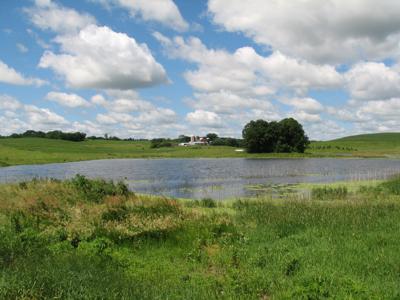Caring for the Minnesota River has been Scott Sparlin’s life’s work.
He’s guided anglers to trophy walleye and catfish, provided tours of the river’s beauty, and seen the river through literal and metaphorical highs and lows from his home in New Ulm.
For the past 32 years, he has served as executive director of the Coalition for a Clean Minnesota River. In 1995, when Gov. Arne Carlson pledged the state would make the Minnesota River fishable and swimmable within 10 years, Sparlin was part of the Citizen’s Advisory Committee.
The Minnesota River Basin Joint Powers Board, which would later become the Minnesota River Board, was established in statute and put in charge of the initiative. Working together with other established river-based citizen organizations, the Minnesota River Board was able to experience some successes.
Perhaps the most notable success came from the Citizen’s Advisory Committee. Their members flew to Washington D.C., advocating for the Minnesota River Basin Conservation Reserve Enhancement Program. CREP was ultimately approved and funded as a voluntary program that saw 100,000 acres of cropped floodland put into permanent conservation easements in the Minnesota River proper and tributary watersheds.
The Minnesota River Board and its citizen group cooperators also supported stakeholder processes that would address impairments in watersheds as listed by Minnesota Pollution Control Agency.
年后,这些公共输入过程realized in MPCA’s Total Maximum Daily Load public meetings and Watershed Restoration and Protection Strategies, inputs that would be used by the Minnesota Board of Water and Soil Resources for their One Watershed, One Plan program that passed into statute and must be complete for the entire state by 2025.
In 2013, the Minnesota River Board disbanded.
“Several of us that worked with that board, non-government organizations, farm organizations, watershed districts, county commissioners,” Sparlin said. “We felt there were still people interested in continuing on and we had ideas, unfinished business and goals we needed to reach. Those of us left formed the Minnesota River Congress.”
Sparlin said there were always great citizen organizations in the Minnesota River Basin that worked on issues since the late 1980s, such as the Coalition for a Clean Minnesota River, Clean up the River Environment and Friends of the Minnesota Valley.
The Minnesota River Congress worked to unite those organizations and anyone else interested. Sparlin said the Minnesota River Congress sparked many ideas and discussions but kept coming back to issues that were rooted ultimately in a similar problem in the watershed: lack of water storage.
到2018年,水储存成为顶级focus. By 2020, Sparlin and the Minnesota River Congress had rounded up an impressive list of supporters for a proposed water storage funding bill as well as bipartisan House and Senate authors. Given the limitations of the pandemic-stricken 2020 legislative session, no action was taken.
However, this year, Senate File 1037 and House File 261 were introduced, promoting appropriations for water storage funding through existing state agencies.
As of this writing, water storage language with appropriations has made it into both the House and Senate Omnibus Natural Resources bills.
The need and timing for water storage in the Minnesota River watershed, and in other watersheds around the state, is great and has never been more urgent, Sparlin said.
“The precipitation trends are all headed towards larger events coming in shorter periods of time,” he said. “If we can’t hold some water back, we’re going to continue down the wrong path.”
众多的湖泊和湿地中Minnesota River basin, and in other streams in agricultural Minnesota, were drained as the land was settled; original public land survey maps show extensive networks of wetlands across much of what was the prairie region of Minnesota.
Human development continues to accelerate water drainage to major rivers. Urban areas are putting more impervious infrastructure on the landscape, storm drains are designed to move water hastily off the landscape, and on farmland, public and private ditches connect to more drain tile, sending water quickly to lakes and streams.
“It really speaks to why water storage is so important, especially to voters and taxpayers,” Sparlin said. “We’re all dealing with the effects to infrastructure in cities and people’s homes and property. Wildlife is losing habitat, crops are washing out, and our smaller streams are not stable — their banks are being eaten away.”
Sparlin noted that streams are scaled and evolved to a certain size, based on their contributing area in the watershed and for precipitation patterns typical to the region. Historically, water was slowly released to these streams in the natural fluctuations of the water cycle.
But now, Sparlin said, we’ve reached a point where it is too much, and the symptoms of a lack of water storage will only get worse.
“We’ve got to stop the blowout of small streams that are contributing sediment, look at the accumulation of sediment that is occurring in Lake Pepin,” Sparlin said. “These small streams were not calibrated to take the force they are taking now. ... We need to store water where it falls and do so strategically.”
Sparlin is asking Minnesotans to recognize the importance of water storage and to start to fund the concept accordingly.
“I’d liken it to a freeway metering system. We’ve got to start metering water, and we have the ability. We have the technical expertise to pull this off. It’s not the same in Lac Qui Parle county as it is in Carver County. It’s not the same in Blue Earth County as in Cottonwood County. ... We’ve tried to capture that spirit and intent in this water storage bill. Wherever, however, whenever, water storage can be done.”
Sparlin’s time working with conservation organizations and natural resource professionals helped him find a consensus.
“Go talk to Soil and Water Conservation Districts, to watershed districts, to the Board of Water and Soil Resources,” he said. “Water storage is the top priority in many places dealing with these issues, but there is no money to do it. This bill is our state making it a priority and when established, we can then potentially partner with other existing programs. ... We already have the tools available to say where the biggest bang for your buck can go. But you can’t get people to sign up if there is no money. This is for willing landowners — no one is forcing anyone to do anything, and if it is done right, it will be a no brainer.”
Sparlin maintained that if Minnesota can fund water storage at a big enough level and demonstrate that it works, there will be federal attention, interest and support.
“I’m confident the federal government at some point will help,” Sparlin said. “When we worked on the Conservation Reserve Enhancement Program, it was a $267 million program.
“It was laid at the table of the state, which would then have to pony up $54 million to help. We used it successfully to put lands back in the Minnesota River floodplain. It can work in reverse too for water storage, of that I’m certain.”
Sparlin believes that water storage needs to be adaptable to any and all potential solutions.
“It can be wetland restoration or water and sediment control basins,” he said. “It can be soil health initiatives that capture carbon, enrich productivity, but also allow soil to hold more moisture. It can be cover crops that take up water, provide perennial cover, and reduce overland runoff. The amount of water holding capacity should be what drives the funding.
“Let’s take a tiered approach to what goes where. An acreage with a permanent wetland easement could be the highest order, but what about a temporary wetland easement or maybe a flowage easement? What about the other temporary water holding solutions? It would be a setup where water is being held back but you’re allowing the landowner the flexibility to do what they want with the land after a surge of water.”
He said that if the land gets drained after a period of time and if conditions are right, the landowner may want to get a crop in.
But it has to have capacity to hold and meter water during rainfall or snowmelt events.
“There’s a whole library of best management practices that can be advantageous just for holding water in the soil profile,” he said. “We’re taking a comprehensive look — any way shape or form of holding water back. We’ve got great talent in Minnesota that can engineer solutions. What we don’t have is the incentive dollars to actually do anything.
“We need these solutions so that people in Minnesota aren’t suffering. So we can tell people in Henderson, Minnesota, that they don’t have to be landlocked for three, four months out of the year, can’t get the kids back to school without half an hour extra time, can’t get ambulance service. So that Lake Pepin isn’t filling at a rate that is an order of magnitude faster than it ever was before we changed the landscape. So that township culvert crossings aren’t blowing out and a farmer isn’t watching his crop wash out in the all-too-common 100-year flood.”
Sparlin’s water storage proposal is on the mark. As time goes on, people forget how much streams in Minnesota have changed. The public’s collective baseline of what is normal shifts; some believe that our rivers are supposed to go from nearly dry to extreme surges.
They’re not.
It’s time to embrace the idea of water storage and the value of ecosystem services — of soil health, of wetland restoration, of preventing loss of lives and infrastructure, of secondarily benefiting from additional fish and wildlife habitat.
Funding water storage in agricultural Minnesota may be the next great conservation success story with benefits for all citizens.
Scott Mackenthun is an outdoors enthusiast who has been writing about hunting and fishing since 2005. He resides in New Prague and may be contacted atscott.mackenthun@gmail.com.





























Commented
Sorry, there are no recent results for popular commented articles.